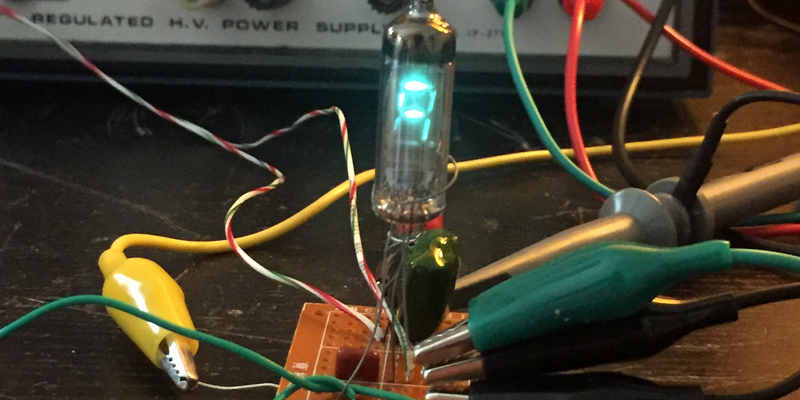A tube is a tube is a tube. If one side emits electrons, another collects them, and a further terminal can block them, you just know that someone’s going to use it as an amplifier. And so when [Asa] had a bunch of odd Russian Numitron tubes on hand, an amplifier was pretty much a foregone conclusion.
A Numitron is a “low-voltage Nixie”, or more correctly a single-digit VFD in a Nixiesque form factor. So you could quibble that there’s nothing new here. But if you dig into the PDF writeup, you’ll find that the tubes have been very nicely characterised, situating this project halfway between dirty hack and quality lab work.
It’s been a while since we’ve run a VFD-based amplifier project, but it’s by no means the first time. Indeed, we seem to run one every couple years. For instance, here is a writeup from 2010, and the next in 2013. Extrapolating forward, you’re going to have to wait until 2019 before you see this topic again.















First piece for a Numitron to play probably ought to be John Cage’s ” 4’33” “. Bonus perk: it’s real easy on the tube.
Meh, you need a class D amp to fully represent that track in its entire spectral complexity. Toobs just aren’t up to it.
“Extrapolating forward, you’re going to have to wait until 2019 before you see this topic again.”
Ohh hell no! There will be moar VFDs-as-valves and they will appear moar frequently! *shakes fist*
(Doing one of these is on my list of things to attempt.)
P.S.: There is probably a TV CRT-as-an-amplifier somewhere. :D
pdf about Numitron tubes from rca
http://www.rfcafe.com/references/popular-electronics/images2/rca-dr2010-numitron.pdf
Don’t forget that most Numitrons are of the incandescent filament type.
http://hackaday.com/2011/12/21/numitron-tube-tutorial/
Perhaps. But useless for amplification.
The tube on the picture is actually a VFD. As someone has stated already, numitrons use filaments and low voltage (few volts). VFDs use relatively low voltage (few tens of volts) and some sort of fluorescent material. Nixies (we call them digitrons) use glow discharge and relatively high voltage (hundred or more volts).
I had to smile at another previous article I found on HaD – “…. the ten number-shaped filaments in each Nixie….”!
http://hackaday.com/2011/12/21/numitron-tube-tutorial/
Hackaday linked to my VFD amplifier in 2008.
http://hackaday.com/blog/page/2/?s=friedrichs
It’s clear that the spirit of HAD is dead when even an author doesn’t know the distinction between a numitron and a vfd.
Ooof this kind of hurts. The use of numitron,VFD,nixie as if they are interchangeable and the use of “nixie-esque” is kind of jarring.
I wouldn’t blame the author tough. Blame all those people that try to draw attention to their Projects,Products and Ebay listings by using as many tube keywords as possible. The ones who call VFD and Numitron tubes “Nixies” to pop up in search results for nixie tubes. It’s a shame that non-neon display tubes don’t get as much attention as the Nixies (I love their soft glowing sea-green colour), but yeah it’s kind of shameless how all Display tubes are being marketed as Nixies leading to goofs like this.
For those curious: A Nixie is a neon-based display tube. A Numitron uses incandescent filaments, VFD uses phosphor and “Nixiesque” doesn’t exist (display tubes are display tubes).